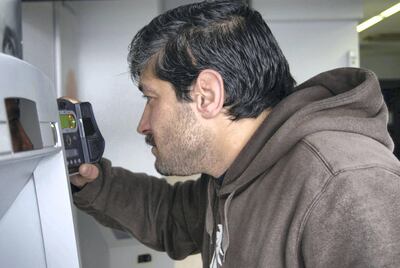The scale of humanitarian crises across the globe is now such that organisations are turning to technology to help more people quicker and more efficiently.
From iris scans to face recognition and digital food shopping, the humanitarian landscape has turned technological, at a time when more than 65 million people were forced from their homes last year.
While the statistics paint a bleak picture - from 2000 to 2016, more than 3.5 billion people were affected by natural disasters and humanitarian crises - the number of new e-initiatives coming to fruition around the globe are helping to counter the swelling numbers by changing refugees’ lives for the better.
“For us, we’re using innovation wherever we possibly can in terms of reception capabilities,” said Toby Harward, head of the United Nations High Commissioner for Refugees (UNHCR) in Abu Dhabi.
“We’re dealing with huge amounts of people and the issue is always: how can we receive and register large amounts of people as quickly as possible? So UPS [the delivery company] developed a very useful handheld data implementation tool by using iris scan to ensure identification when people are registered.”
The tool has made registration of refugees a much easier and digital-based process but Mr Harward said there are other innovations that are helping to improve refugees’ living standards, such as cash assistance using retina scans.
“We’re now helping about 33,000 of the most vulnerable Syrian refugees in Jordan through a cash assistance programme,” he said. “These are refugees who had cash when they left Syria but, five years later, have ran out. About 85 per cent of Syrian refugees live in Amman and other cities, with only 15 per cent in camps.”
The organisation provides them with monthly funds by scanning their retina through any Cairo Amman Bank ATM, without the need for a card or PIN number.

“We’re expanding it in parts of Africa and we see this very much as the future of aid because it empowers refugee families to make their own decisions on how they’re going to spend what they receive,” Mr Harward said. “Studies showed that more than 99 per cent of money given out in cash assistance is indeed spent on the essentials, not misspent on drugs and alcohol. It’s defining the future of how we envisage aid given out.”
Dubai Government has just authorised a flight full of essential material to the Rohingya Muslims being persecuted in Myanmar but the UNHCR is also looking at cash assistance to empower refugees and help local markets there.
“With refugees being displaced for an average period of 17 years, you’re not just dealing with a short-term displacement problem and that can’t be addressed through short-term humanitarian relief like camps, shelter and food,” Mr Harward said. “You have to provide them with an education and to ensure they have livelihoods to keep them busy and fulfilled so as not to let generations in camps just get lost and go to waste. You have to give them hope.”
In Germany, the UN World Food Programme set up “humanitarian accelerators” with the government and private sector to produce innovative solutions to drive the world towards zero hunger.
“People hand in their ideas and the best are invited to a camp in Munich to develop and implement it in the field,” said Doris Mauron, from the WFP. “[We] are using iris scans to better regulate food assistance and refugees can now purchase food at supermarkets by getting their eyes scanned. Refugees need more than just a tent – they need a phone, protection and help.”
Through the accelerators, which are also being championed in the UAE, two projects in Jordan were set up involving the establishment of an agriculture technology platform using robotic systems to grow crops to help refugee communities become self-reliant.
Across Europe, the Red Cross and Red Crescent societies have used the internet to build a tracing service so refugees can be reunited with their families. Trace The Face posts and distributes photos of those looking for their loved ones online and on posters.
“Geographical location is the biggest challenge because refugees move a lot,” said Lucille Marbeau, regional delegation spokeswoman at the International Committee for the Red Cross in Paris. “We’re getting more and more matches. If you consider the issue of missing people, this is a unique position to help them because there are offices in each country in the world and the information is shared between offices.
“Today we have to use all available tools that can help in making our services known to migrants.”


